Standards Worldwide
Standards Worldwide
Phone +49 30 58885700-07

Standard [CURRENT]
ASTM E 1935:1997
Standard Test Method for Calibrating and Measuring CT Density
- Publication date
- 1997 reapproved: 2019
- Original language
- English
- Pages
- 5
- Publication date
- 1997 reapproved: 2019
- Original language
- English
- Pages
- 5
- DOI
- https://dx.doi.org/10.1520/E1935-97R19
Product information on this site:
Quick delivery via download or delivery service
Buy securely with a credit card or pay upon receipt of invoice
All transactions are encrypted
Short description
1.1 This test method covers instruction for determining the density calibration of X- and γ-ray computed tomography (CT) systems and for using this information to measure material densities from CT images. The calibration is based on an examination of the CT image of a disk of material with embedded specimens of known composition and density. The measured mean CT values of the known standards are determined from an analysis of the image, and their linear attenuation coefficients are determined by multiplying their measured physical density by their published mass attenuation coefficient. The density calibration is performed by applying a linear regression to the data. Once calibrated, the linear attenuation coefficient of an unknown feature in an image can be measured from a determination of its mean CT value. Its density can then be extracted from a knowledge of its mass attenuation coefficient, or one representative of the feature. 1.2 CT provides an excellent method of nondestructively measuring density variations, which would be very difficult to quantify otherwise. Density is inherently a volumetric property of matter. As the measurement volume shrinks, local material inhomogeneities become more important; and measured values will begin to vary about the bulk density value of the material. 1.3 All values are stated in SI units. 1.4 This standard does not purport to address the safety concerns, if any, associated with its use. It is the responsibility of the user of this standard to establish appropriate safety and health practices and determine the applicability of regulatory limitations prior to use.
ICS
35.240.80
DOI
https://dx.doi.org/10.1520/E1935-97R19
Loading recommended items...
Loading recommended items...
Loading recommended items...
Loading recommended items...
